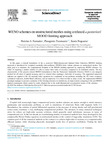Mostrar o rexistro simple do ítem
WENO Schemes on Unstructured Meshes Using a Relaxed a Posteriori MOOD Limiting Approach
| dc.contributor.author | Farmakis, Pericles S. | |
| dc.contributor.author | Tsoutsanis, Panagiotis | |
| dc.contributor.author | Nogueira, Xesús | |
| dc.date.accessioned | 2020-03-09T17:01:45Z | |
| dc.date.available | 2020-03-09T17:01:45Z | |
| dc.date.issued | 2020 | |
| dc.identifier.citation | Farmakis, P.S., Tsoutsanis, P., Nogueira, X., 2020. WENO schemes on unstructured meshes using a relaxed a posteriori MOOD limiting approach. Computer Methods in Applied Mechanics and Engineering 363, 112921. https://doi.org/10.1016/j.cma.2020.112921 | es_ES |
| dc.identifier.uri | http://hdl.handle.net/2183/25141 | |
| dc.description | Os datos relativos aos resultados deste artigo poden descargarse desde https://doi.org/10.17862/cranfield.rd.11836164.v1 baixo unha licenza CC-BY 4.0. | es_ES |
| dc.description.abstract | [Abstract] In this paper a relaxed formulation of the a posteriori Multi-dimensional Optimal Order Detection (MOOD) limiting approach is introduced for weighted essentially non-oscillatory (WENO) finite volume schemes on unstructured meshes. The main goal is to minimise the computational footprint of the MOOD limiting approach by employing WENO schemes—by virtue of requiring a smaller number of cells to reduce their order of accuracy compared to an unlimited scheme. The key characteristic of the present relaxed MOOD formulation is that the Numerical Admissible Detector (NAD) is not uniquely defined for all orders of spatial accuracy, and it is relaxed when reaching a 2nd-order of accuracy. The augmented numerical schemes are applied to the 2D unsteady Euler equations for a multitude of test problems including the 2D vortex evolution, cylindrical explosion, double-Mach reflection, and an implosion. It is observed that in many events, the implemented MOOD paradigm manages to preserve symmetry of the forming structures in simulations, an improvement comparing to the non-MOOD limited counterparts which cannot be easily obtained due to the multi-dimensional reconstruction nature of the schemes. | es_ES |
| dc.description.sponsorship | The authors acknowledge the computing time on the UK national high-performance computing service ARCHER that was provided through the UK Turbulence Consortium in the framework of the EPSRC, United Kingdom grant EP/L000261/1 and the computing time on the University of Cambridge Tier-2 national high-performance computing service Peta4 provided through the EPSRC, United Kingdom grant EP/P020259/1. X. Nogueira has been partially supported by FEDER, Spain funds of the European Union, Grant RTI2018-093366-B-I00 of the Ministerio de Ciencia, Innovación y Universidades of the Spanish Government | es_ES |
| dc.description.sponsorship | Reino Unido. Engineering and Physical Sciences Research Council; EP/L000261/1 | es_ES |
| dc.description.sponsorship | Reino Unido. Engineering and Physical Sciences Research Council; EP/P020259/1 | es_ES |
| dc.description.uri | https://doi.org/10.17862/cranfield.rd.11836164.v1 | |
| dc.language.iso | eng | es_ES |
| dc.publisher | Elsevier | es_ES |
| dc.relation | info:eu-repo/grantAgreement/AEI/Plan Estatal de Investigación Científica y Técnica y de Innovación 2017-2020/RTI2018-093366-B-I00/ES/NUEVOS METODOS SIN MALLA PARA LA SIMULACION NUMERICA DE FLUJOS TURBULENTOS Y PROBLEMAS DE MULTIFISICA. APLICACION AL DESARROLLO DE SISTEMAS DE GENERACION DE ENERGIA RENOVABLE | |
| dc.relation.uri | https://doi.org/10.1016/j.cma.2020.112921 | es_ES |
| dc.rights | Atribución 4.0 Internacional (CC BY 4.0) | es_ES |
| dc.rights.uri | https://creativecommons.org/licenses/by/4.0/ | * |
| dc.subject | MOOD | es_ES |
| dc.subject | WENO | es_ES |
| dc.subject | Unstructured | es_ES |
| dc.subject | RMI | es_ES |
| dc.subject | UCNS3D | es_ES |
| dc.title | WENO Schemes on Unstructured Meshes Using a Relaxed a Posteriori MOOD Limiting Approach | es_ES |
| dc.type | info:eu-repo/semantics/article | es_ES |
| dc.rights.access | info:eu-repo/semantics/openAccess | es_ES |
| UDC.journalTitle | Computer Methods in Applied Mechanics and Engineering | es_ES |
| UDC.volume | 363 | es_ES |
| UDC.startPage | 112921 | es_ES |
| dc.identifier.doi | 10.1016/j.cma.2020.112921 |
Ficheiros no ítem
Este ítem aparece na(s) seguinte(s) colección(s)
-
GI-GMNE - Artigos [55]






